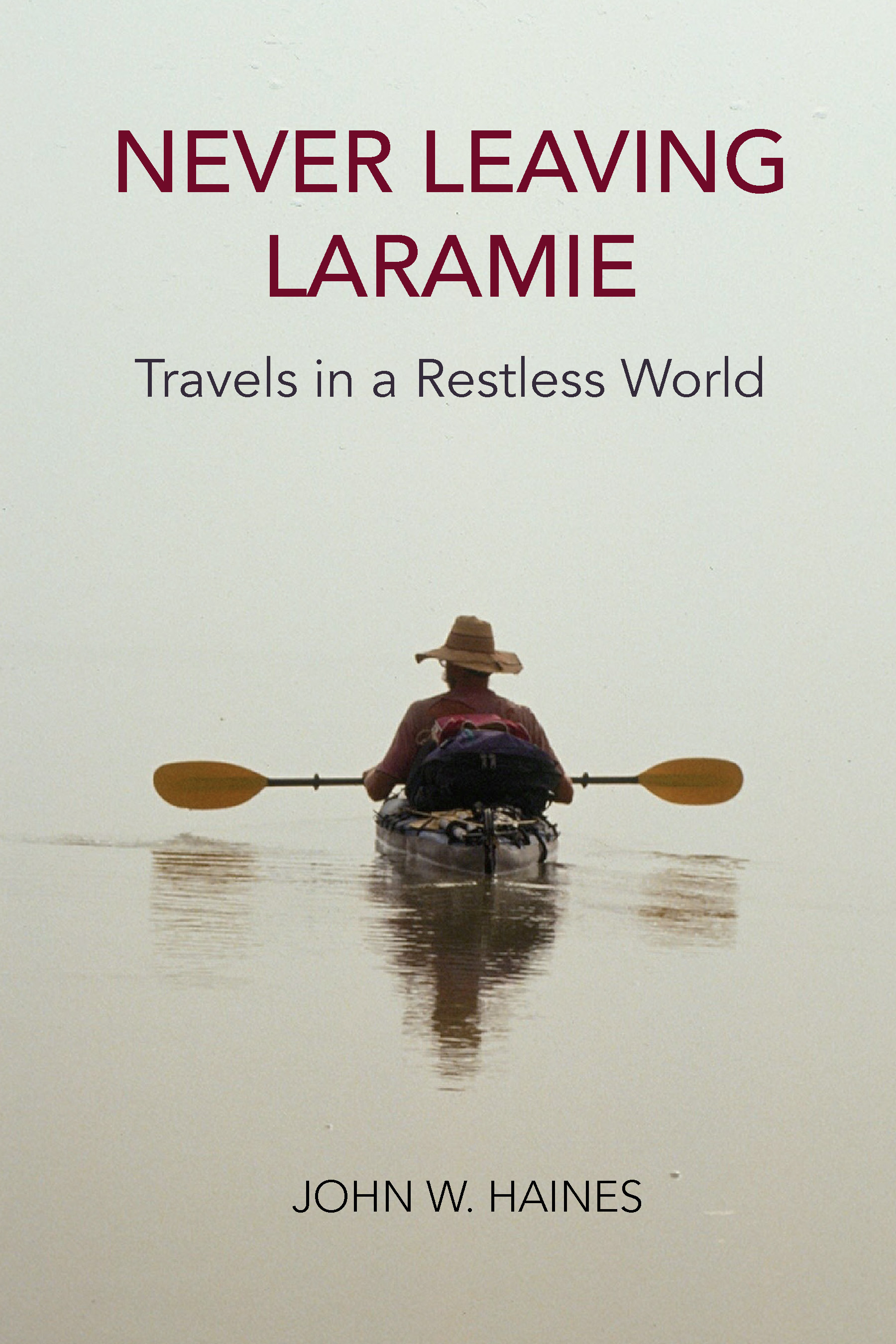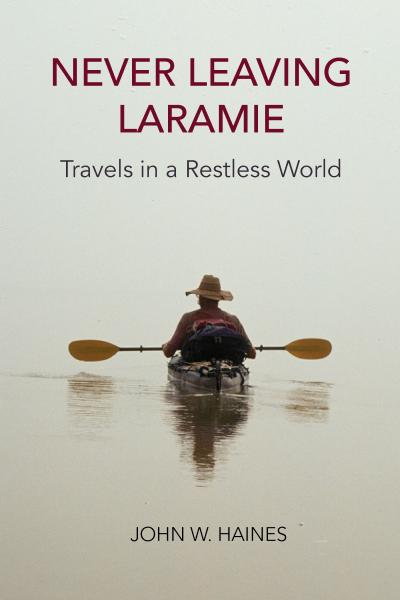John Haines—writer, community investor, and adventurer— kayaks, bikes, and survives various terrains in his first book, Never Leaving Laramie: Travels in a Restless World. Haines traverses multiple continents, and the message of taking risks and experiencing life stays at the  core. From Laramie, Wyoming, to Mali, Africa, the need for independence and adventure run wild through Haines’s writing and voice. In this interview, Haines takes a moment to dive deeper into the intrepid waters of his life on and off the river.
core. From Laramie, Wyoming, to Mali, Africa, the need for independence and adventure run wild through Haines’s writing and voice. In this interview, Haines takes a moment to dive deeper into the intrepid waters of his life on and off the river.
OSU Press: Who is John Haines beyond the author bio?
John Haines: The central theme for my life is starting things. I have started a couple of nonprofits and loan funds in hard cities on the east coast. I’ve also worked in Central Europe in finance with the Czech Environmental Fund and with the Romanian government. I’ve worked around the world from Portland to Trenton, New Jersey, to Bucharest. I’ve always had an eye on financial systems and economics.
OSU Press: Never Leaving Laramie: Travels in a Restless World is a beautiful tale of experiences across the world. With the world quarantined due to COVID-19 and experiencing restlessness, what tips do you have for folks who are itching to escape?
John Haines: What I do is read a lot. I’m reading more than I ever have. I go to this beautiful wetland and sit, read, and watch the cycle of what’s happening with the birds and noises and then I do that around the region. I’m in a wheelchair, so what I would do otherwise is be out in wilderness as remote as I can get. Find something beautiful and learn about it, whether it’s words or trees as they change. Spending more direct attention on our own surroundings seems like the best thing to do. And then dream and read about where to go.
OSU Press: What does traveling teach you about yourself and the world?
John Haines: For me, everything. I think I most often traveled either alone or without an itinerary, except later in life. Usually, I went without a return ticket or with one that was expandable so I wouldn’t come back on the same route, and I always took books about where I was, most often fiction or history, not guide books. Traveling alone or with one person and being in a position where you’re not distracted by TVs or big hotels so you have time to read, think, and observe and just sit on a corner day after day and look at things. I think it teaches you patience. After our Group Leadership Meetings for Mercy Corps, I would take time to go out in Nepal; Abu Dhabi; Egypt; and Uganda and go bird watching. Birds open up the landscape for me, always have, and I reflect on that a bit on the Niger River.
OSU Press: During your Niger River expedition, you mention that, “The Niger had put me on a river for life. Move, experience everything, but do not be captured by any one place or thing” (174). Can you speak more to how rivers and water have helped guide you through your travels? Through writing your book?
John Haines: There’s a saying by Leonardo da Vinci I use in the beginning of Chapter 12 (What the River Says): “In rivers, the water that you touch is the last of what has passed and the first of that which comes.” The river is never the same. It’s there, then it’s gone. There’s a reference to Zen poetry and philosophy in the book from when I was in Japan. One of the things they talked about was feeling everything fully but not letting any one feeling overwhelm you. That was a really good thing to read when I was traveling alone when it was winter and kind of miserable. It puts me in that beginner’s mind. It doesn’t feel good; it’s cold, it’s lonely, I hadn’t talked to anyone for two weeks. Putting yourself in a beginner’s mind to appreciate that is, I think, a metaphor for the movement of rivers.
OSU Press: How did the water impact your relationships with the people that live on the Niger river or near it?
John Haines: We were so tethered to that river. We’d be on the river for 12 hours a day; it was part of us. We were only on land to sleep and eat so we never strayed too far from the river. We were very immersed with the river and the people who were on it or next to it. You’re going to their home, not yours—even though you feel tethered to it for months. You come into interactions there with humility and respect for the people who have lived there for centuries. That river is everything to them. You need to share yourself when you arrive in a place like that and it takes some energy. They’ll dig through your kayak, kids will want to play with the paddle, the chief will want to go on your boat—you take a deep breath, stop a couple hours early, and put yourself in the parade.
OSU Press: How was traveling as a quadriplegic in a world that wasn’t designed to accommodate folks of various abilities?
John Haines: I’m the first one off and on. If I have a connecting flight, I might miss it. It takes extraordinary patience. It can be dangerous. I just take a deep breath and say let’s go with it. Most of my trips have been alone all over US and around the world, since I do domestic work for Mercy Corps and we do Global Leadership Meetings. The China meeting was first, then Scotland, Nepal, Abu Dhabi, Egypt, Uganda, and Europe a few times so I got fairly used to doing it in a chair. If you arrive in Cairo after midnight by yourself and you don’t have any money and you’re dead tired after going to Portland from Amsterdam to there, you better wake up.
OSU Press: What do you wish people knew more about wheelchair users and folks with various abilities?
John Haines: I don’t have that much judgement of people unless they already have a preconceived idea of who I am. So, if you get a group of people in a wheelchair together and, man, you want to see diversity? Age, gender, background, the stories . . . everyone has a story. Not everyone is attitude driven. They’re pretty much impaired and learned flexibility for a world that isn’t quite right for you. By and large, you can’t get upset by the door that doesn’t work, people that cut you off, or whatever it is. There is always something that doesn’t work.
OSU Press: Never Leaving Laramie is a book filled with adventure. For those wanting to get outside and see new places, what advice would you give them?
John Haines: This may sound crazy, but don’t make too much of a preconceived plan, or you’ll just follow the plan and you won’t be surprised by the things that are out there. Go with an open mind and if you can, go alone and just sit and watch things. Take time. Take your watch off, take off the plug-ins. When I was traveling, I couldn’t have any of that. Even finding a phone in some of the cities was a bear, to call home and say I’m still alive. I’d send letters, but they [family] wouldn’t get them until two to three weeks later. Now, we’re so in tune to the luxury of connecting with anybody at any time. On the Niger River, we didn’t have maps for the upper region. We had some weird defense-mapping agency maps from the US government but they didn’t have any detail. They weren’t helpful at all. So, we had no maps whatsoever. Literally just going at the direction of asking people and finding Sori who led us. He was our map.
OSU Press: Can you tell me more about Laramie, Wyoming, and how your hometown relates to the places you’ve traveled?
John Haines: Laramie really breathes independence. The austerity, the cold, the cowboys, the hunters, and people that do stuff in the outdoors that is seemingly dangerous. Everyone has a level of risk-taking and adventure built into them because we’re isolated. What we do is what’s outside and we can’t get enough of it. Everyone there comes with an independent streak and my contention is that we never lose that through the course of our lives. When you’re in New York City you have a different type of adventure. I know people that grew up in the city and they cruised neighborhoods more widely where you can see so much of the world in five blocks, which you just don’t see in Wyoming.
OSU Press: Where’s your favorite adventure?
John Haines: The next one . . . the next place. I like so many places for specific reasons but you know what you find? It’s like as much as you love a place like Kathmandu, Nepal . . . I hadn’t been back in 21 years and, my gosh, I couldn’t recognize the city at all because it was so polluted and built over. So sometimes you can never go back. But then I went down into Southern Nepal and saw birds and rhino. A part of Nepal I would have never seen because I was so glued to the mountains. Anything in the Himalayas is attractive and the republic of Georgia and the Slavic countries are really interesting. It’s impossible to go to Africa and not have it stuck in your heart forever, and the Niger River in particular—the people that were related to that river, who don’t bounce too far from it, appealed to a calming continuity.
Related Titles

Never Leaving Laramie
John Haines spent the better part of the 1980s and 1990s traveling the world: biking through Tibet, kayaking the length of the Niger River, taking...
